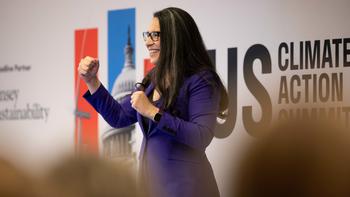The City of Melbourne is delivering improvements to the city transport network to make it easier for more people to get back into and around the city.
Lord Mayor Sally Capp said an independent review was undertaken by Deloitte in response to community feedback, to assess demands and attitudes across all modes of transport, as well as the future needs of the city.
“We’ve used the lockdown to take action in response to feedback from the community. We reviewed our transport system because we want to ensure it works for everyone, so we can get as many people back into the city as quickly as possible,” the Lord Mayor said.
Transport and Infrastructure deputy portfolio lead, Councillor Roshena Campbell, said more needs to be done to entice city workers back and support businesses.
“We’ve heard the clear message that we need to make improvements so that it is easier to come into and move around the city. We have already delivered 60 improvements and many more are underway,” Cr Campbell said.
Shoppers and traders will benefit from additional pick-up and drop-off parking spaces to accommodate click and collect services – a reflection of shopping behaviour changes brought about by the pandemic. There are also more loading spaces to support trader needs.
To build on the actions already undertaken and underway, the review made five strategic recommendations which could be implemented within 12 months – designed to fast-track the city’s economic recovery, including:
- Flexible work hours to manage peak demand
- Re-allocation of road and parking spaces for local activation, such as on-street dining
- Demand-responsive parking pricing to encourage off-peak visits
- Removing key physical touchpoints across the CBD
- Real-time public transport tracking and capacity data
On top of the City of Melbourne’s own initiatives, Councillors will also consider advocating to the Victorian Government for cheaper off-peak travel to reduce public transport congestion on weekdays, and waiving public transport fares for events and special occasions.
“Public transport has the most capacity to bring more people into the city at all hours – and the transport review has told us it is the best way to bring back the buzz quickly,” the Lord Mayor said.
Before COVID-19, the single largest drawcard for entering the CBD was for work – making up 75 per cent of public transport trips.
The review confirmed through-traffic is the major culprit for peak hour congestion, with action already underway to target pinch points – and it called for continuous monitoring of transport flow to help keep people moving.
The City of Melbourne and Department of Transport will consider installing new hook turn lanes on to Collins Street from Exhibition Street, to ease traffic congestion and improve safety.
Deloitte’s findings supported Council’s work to deliver protected bike lanes and improve safety for road users, with the review anticipating bike trips to the CBD will exceed pre-pandemic levels with safer infrastructure.
“We’ve seen bike usage double outside the city since the pandemic, and we’re looking forward to testing whether e-scooters could become another safe, environmentally friendly option in the coming months,” the Lord Mayor said.
“Everyone coming into the city is adding value to our economy and we have made improvements for all transport modes so that everyone is a winner.”
Cr Campbell said the report revealed the importance of transport as a key part of the city’s recovery.
“We’ve seen a significant shift from public transport to cars as a result of the pandemic. We are working on improvements to reduce bottlenecks and congestion points so that coming into the city is as easy and stress free as possible,” Cr Campbell said.
Deloitte’s data also showed people would catch trains, trams and buses when there’s something worth travelling for – highlighting the importance of city activation.
Councillors will consider the Deloitte transport review and recommendations at the Future Melbourne Committee meeting on Tuesday 19 October.
Key facts from Deloitte Independent Transport Review:
- Prior to lockdown five (May 2021), less than half (45%) of the CBD’s usual office worker population was attending the office for work.
- Before COVID-19, public transport accounted for roughly 60% of total trips, and the single largest drawcard for entering the CBD was for work – making up 75% of all public transport trips.
- A dip in overall public transport use during the pandemic is largely due to people working from home and wanting to continue working from home, but also reflects traveler concerns relating to catching COVID-19 (37%), restricted movement/not needing to travel as much (32%), concerns about cleanliness (24%), overcrowding (ability to social distance) (23%). Mask enforcement (27%), physical distancing (12%), and more frequent services (19%) are considered important for commuters to return to public transport.
- In May 2021, public transport was the majority mode of travel to the city and had bounced back to 45% of pre-COVID levels during the week and 60% on weekends. Vehicle trips reached 88% of pre-COVID levels due in part to a shift to car from public transport.
- Returning public transport to pre COVID-19 levels would see roughly 64,000 peak hour trips return to the network.
- Roughly 43% of all car trips entering the CBD travel directly through the CBD, without adding any economic benefit. Of the 180,000 trips per day (2019), only 102,000 of the vehicle entries were defined as stopping in the city, 78,000 were deemed as through-trips.
- There is capacity for roughly 5,200 additional car trips in the hour before and after peak hour (7am-8am, and 9am-10am), as well as during off-peak times. Morning peak hour road capacity is 13,600 trips.
- Bike riding in the city dropped to 50% of pre-COVID levels due to people working from home and lack of vehicle congestion. In contrast, bike use outside the city grew by 200%.
- Removing bike lanes would put an extra 800 vehicles on the road during the morning peak hour (8am-9am) – the equivalent of one full train. One bike lane can move roughly double the capacity of one traffic lane.
- When on-street parking meters were uncontrolled, only 18,800 vehicles turned over every day compared with a potential turnover of 37,600. When parking restrictions were reintroduced on Russell Street in November 2020, arrivals increased by 47%.
- In May, CBD-centric bus trips had recovered to ~60% of pre-COVID levels and CBD-centric tram trips had recovered to ~45% of pre-COVID levels.








